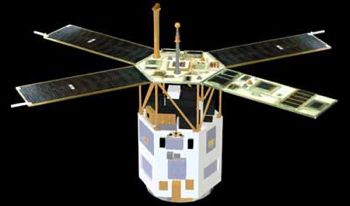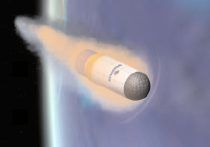APEX (original) (raw)

Home - Search - Browse - Alphabetic Index: 0- 1- 2- 3- 4- 5- 6- 7- 8- 9
A- B- C- D- E- F- G- H- I- J- K- L- M- N- O- P- Q- R- S- T- U- V- W- X- Y- Z
APEX
American technology satellite. P90-6 APEX. Technology satellite built by Orbital Sciences Corporation (OSC) for USAF STP (Space Test Program), USA. Launched 1994. Used the PegaStar bus.
AKA: Advanced Photovoltaic Experiment;P 90. Status: Operational 1994. First Launch: 1994-08-03. Last Launch: 1994-08-03. Number: 1 . Gross mass: 260 kg (570 lb).
APEX successfully tested a wide array of advanced photovoltaic and electronic components in a harsh radiation environment, provided significant data to support improved designs for future space systems. During operation, APEX's highly elliptical orbit allowed the investigation of space plasma effects on high-voltage operation (current leakage at positive voltages and arcing at negative voltages) in the perigee region, plus the investigation of space radiation effects (decreased array power output from passage through the inner radiation belt) in the apogee region.
The spacecraft was based on Orbital Sciences' PegaStar bus which integrated the booster upper stage avionics and spacecraft bus functions. PegaStar could support payloads from 50 to 150 kg and provide up to a 10-year mission life. A modular design supported a wide range of stabilization and pointing requirements. Orbit average power available to the payload was approximately 100W to 200W, depending upon the mission orbit.
The PASP (Photovoltaic Array Space Power) Plus experiment conducted tests on advanced photovoltaic technologies under carefully controlled conditions in order to compare and evaluate the different ways in which solar cell performance was degraded by the space environment. The operation of solar arrays at higher than the standard voltage level (28 volts) could result in much more efficient power production. PASP Plus was able to bias the arrays to both high positive and negative voltages (as high as 500 volts) in order to study how much the voltages could be increased before arcing and sparking occurred. Twelve types of arrays were tested including four silicon-based planar arrays, three gallium-arsenide on germanium planar arrays, three new-material (indium-phosphide and two other multi-bandgap) planar arrays, and two concentrator designs. APEX also hosted the Cosmic Ray Upset Experiment (CRUX), sponsored by NASA's Goddard Space Flight Center; and the Thin-Film Ferroelectric Experiment (FERRO), developed by the Naval Postgraduate School.
Project cost was $ 30 million (the bus was 12M,PegasuscosttoDARPAatthattimewas12M, Pegasus cost to DARPA at that time was 12M,PegasuscosttoDARPAatthattimewas6.5M, and payload -- three instruments -- ca. $10M). Two spacecraft anomalies occurred once the spacecraft was in orbit (battery sensor and memory chip). Both times the spacecraft was successfully reset by ground control.
More at: APEX.
Family: Technology, Technology satellite. Country: USA. Launch Vehicles: Pegasus. Launch Sites: Point Arguello WADZ. Agency: USAF, OSC. Bibliography: 2, 6, 6344, 12050.
Photo Gallery
 |
P90-6 APEXCredit: Manufacturer Image |
|---|
1994 August 3 - . 14:38 GMT - . Launch Site: Point Arguello. Launch Complex: Point Arguello WADZ. Launch Pad: Aircraft from Edwards.. Launch Platform: NB-52 008. Launch Vehicle: Pegasus.
- P90-6 APEX - . Payload: APEX/Orion 38. Mass: 260 kg (570 lb). Nation: USA. Agency: USAF STP. Class: Technology. Type: Navigation technology satellite. Spacecraft Bus: PegaStar. Spacecraft: APEX. USAF Sat Cat: 23191 . COSPAR: 1994-046A. Apogee: 2,534 km (1,574 mi). Perigee: 360 km (220 mi). Inclination: 69.98 deg. Period: 114.82 min. Advanced Photovoltaic and Electronic Experiments; studied radiation and plasma effects on solar power systems. Air dropped in Point Arguello WADZ..
Home - Search - Browse - Alphabetic Index: 0- 1- 2- 3- 4- 5- 6- 7- 8- 9
A- B- C- D- E- F- G- H- I- J- K- L- M- N- O- P- Q- R- S- T- U- V- W- X- Y- Z
© 1997-2019 Mark Wade - Contact
© / Conditions for Use
